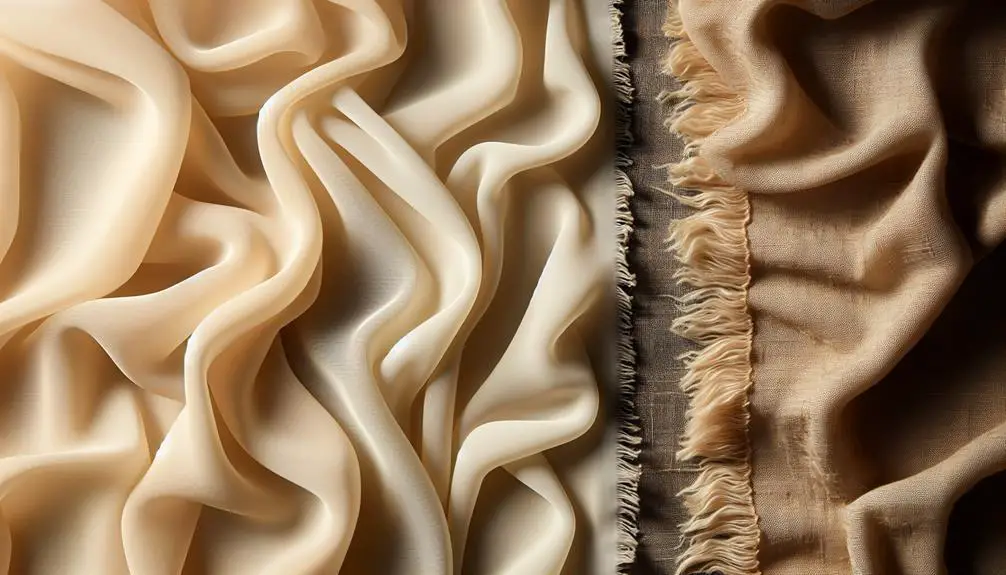Yes, I'd say chiffon is generally good quality. It's lightweight, breathable, and has a lovely silky feel which makes it great for elegant draping. If it's made from silk, polyester, cotton, or rayon, each type brings something special to the table, like durability or a glossy finish. Chiffon is surprisingly tough for how delicate it appears, due to its fine weave. It's versatile enough for both everyday wear and special occasions if you take care of it properly. Wanting to keep your chiffon looking perfect? There are some handy tips and tricks that can help you make the most of this beautiful fabric.
Table of Contents
Key Takeaways
- Chiffon is durable and long-lasting due to its fine mesh-like weave.
- Offers a luxurious feel with its soft, smooth texture and elegant drape.
- Resistant to stretching and wrinkling, maintaining its shape and appearance.
- Available in high-quality varieties like silk, enhancing its overall value.
- Lightweight and breathable, making it comfortable and suitable for various uses.
Understanding Chiffon Fabric
Chiffon is a lightweight, sheer fabric known for its elegant drape and soft, silky texture. I've often found it perfect for creating flowy dresses, scarves, and blouses that require a bit of finesse. It's not just the look that's appealing; its breathability makes it a favorite for summer wear or in climates where keeping cool is crucial.
When I'm evaluating the quality of chiffon, I consider several factors. First, the type of fiber used plays a huge role. Chiffon can be made from silk, polyester, or other synthetic fibers. Silk chiffon is the highest quality, offering an unbeatable sheen and feel. However, polyester chiffon is more durable and much easier to care for, making it a great option for everyday use.
The weave of the fabric also affects its quality. Chiffon's unique twist weaving technique gives it a slight puckering in both directions, creating that slight stretch and solid durability. This is why it holds up well in flowy, delicate designs without sacrificing longevity.
I've learned it's crucial to handle chiffon with care during sewing, as its delicate nature can lead to fraying. Quality chiffon, however, tends to resist fraying better than lower-grade alternatives.
Historical Background of Chiffon
The history of chiffon fabric stretches back over centuries, evolving from a luxury silk material to the versatile textile used today in various fashion pieces. Originally, this fabric was exclusively made from silk, making it a symbol of wealth and status among the elite. Its name, derived from the French word for 'cloth,' is a testament to its esteemed beginnings.
To give you a clearer picture of its historical journey, consider these points:
- Royal Garments: In the past, chiffon was often used in the wardrobes of royalty and nobility across various cultures. Its light, airy nature made it a favorite for elaborate gowns and robes, signifying sophistication.
- Cultural Shifts: As trade routes expanded, chiffon's popularity spread globally. Over time, it began to reflect not only luxury but also the blending of cultural fashion influences.
- Technological Advancements: The development of synthetic fibers in the 20th century transformed chiffon production. This led to more affordable versions being available, which allowed it to become a staple in everyday fashion, not just high-end couture.
Understanding this evolution helps us appreciate not just the quality of chiffon but also its significance in fashion history. Its journey from a luxurious item to an accessible fashion staple is truly fascinating.
Types and Varieties
Now let's look at the different types and varieties of chiffon available today. Chiffon can be made from various fibers, each giving it unique qualities. I've broken down some popular types into a simple table to help you get a clear picture:
| Type | Fiber Used |
|---|---|
| Silk Chiffon | Silk |
| Polyester Chiffon | Polyester |
| Cotton Chiffon | Cotton |
| Rayon Chiffon | Rayon |
Silk chiffon is the most traditional form, known for its sheer, elegant texture and natural fiber. It's a favorite for luxurious garments. Polyester chiffon, on the other hand, is more durable and less expensive, making it a popular choice for everyday wear as well as formal attire. It's also easier to handle and maintain.
Cotton chiffon brings the comfort of cotton but with the lightness typical of chiffon, offering a blend that's great for casual outfits. Lastly, rayon chiffon is a bit heavier, drapes beautifully, and offers a slightly glossy finish which can really elevate a piece.
Each type has its place, depending on what you're looking for in terms of feel, durability, and care requirements.
Key Characteristics
While exploring chiffon's various types, it's crucial to understand its key characteristics that make it a versatile fabric choice. Let's delve into what truly sets chiffon apart.
- Sheerness: Chiffon is known for its sheer, translucent quality. This makes it ideal for layering in fashion designs, giving outfits a delicate and airy appearance. Whether it's a breezy summer dress or an elegant scarf, the sheerness of chiffon adds a touch of sophistication without adding weight.
- Lightness: It's incredibly lightweight, which is why it's a favorite for many when it comes to comfortable, breathable clothing. This characteristic allows chiffon garments to flow and drape beautifully, conforming softly to the body's shape and movements.
- Texture: Chiffon possesses a slightly rough texture due to the twists in the yarns used during weaving. This unique texture not only contributes to its aesthetic appeal but also provides a slight grip that helps in handling the fabric during the sewing process.
These characteristics make chiffon not just popular in fashion but also in decor, where its elegance and light diffusing properties can transform spaces. Understanding these aspects helps in appreciating why chiffon remains a cherished choice in various creative fields.
Durability and Wear
Despite its delicate appearance, chiffon is surprisingly durable and can withstand regular wear if handled properly. Now, when I first came across chiffon, I'll admit, I was a bit skeptical. It looks so light and airy, almost like it would tear if you just glanced at it too harshly! But here's the scoop: chiffon's magic lies in its weaving. Made typically from silk, polyester, or rayon, its fine mesh-like weave gives it a strength that's not immediately apparent.
I've worn chiffon dresses to countless events, and they've held up beautifully. Think about those breezy summer weddings or elegant evening parties—chiffon is a go-to because it not only looks graceful but also lasts through the night. It's resilient in ways that defy its floaty, ethereal look.
You might wonder how something so seemingly fragile keeps its shape and texture, right? Well, it's all about the fibers and how tightly they're woven. Even after multiple wears, my chiffon outfits maintain their form. They don't sag or stretch out, which honestly, makes them a fantastic choice for both daily wear and special occasions. So, don't let the softness fool you; chiffon is tougher than it looks!
Maintenance and Care
Now, let's talk about how to take care of chiffon so it stays looking great.
I'll cover how to:
- wash it properly,
- iron it without causing damage, and
- store it to avoid wrinkles and snags.
Each point is crucial for maintaining the elegant appearance of your chiffon garments.
Washing Chiffon Fabric
To maintain the delicate quality of chiffon, it's crucial to wash it properly. Let me break it down simply:
- Choose the right detergent: Opt for a mild detergent. Harsh chemicals can damage the fabric fibers, making them lose their sheerness and softness.
- Hand wash gently: Avoid throwing your chiffon garments into the washing machine. Instead, gently hand wash them in lukewarm water. This prevents the material from snagging and tearing.
- Air dry: Never wring out chiffon; it's way too fragile for that. After washing, lay the fabric flat on a towel to air dry. This method helps retain its shape and avoids unnecessary stretching or distortion.
With these steps, you'll keep your chiffon looking impeccable!
Ironing Chiffon Correctly
After keeping your chiffon clean, it's also important to iron it the right way to maintain its quality.
When you're ready to iron, set your iron to the lowest heat setting. Chiffon can easily burn or melt under high heat.
I always place a pressing cloth between the iron and the chiffon fabric. This barrier prevents any direct contact and protects the delicate fibers.
Gently press the iron down and keep it moving. Don't let it sit in one spot for too long. If you notice any wrinkles that are stubborn, use steam lightly.
Storing Chiffon Safely
Properly storing your chiffon is key to keeping it in great condition for years. When you're not wearing it, here's what I do to make sure my chiffon stays pristine:
- Use Padded Hangers: These prevent creases and maintain the shape of your garments. Wire hangers can poke through delicate fabrics like chiffon, causing damage.
- Avoid Sunlight: I always store my chiffon away from direct sunlight. UV rays can fade the colors and weaken the fabric over time. A dark, cool closet is ideal.
- Give It Space: I never overcrowd my chiffon items in the closet. They need room to breathe to avoid unnecessary wrinkles and preserve the fabric's integrity.
Comfort and Wearability
Chiffon is incredibly comfortable to wear, feeling light and airy against the skin. It's one of those fabrics that you barely notice you're wearing because it's so featherlight. This quality makes it perfect for long events or hot days when heavier fabrics might feel stifling. I've worn chiffon dresses to weddings and summer gatherings, and the comfort it offers is unmatched.
The fabric's breathability is a huge plus. Chiffon allows air to flow freely, which helps in regulating body temperature, keeping you cool. But it's not just about feeling cool; the soft texture of chiffon against the skin is genuinely soothing. It doesn't irritate or feel rough, which is crucial for me as I have sensitive skin.
Here's a simple table to break down chiffon's key comfort features:
| Feature | Benefit | Relevance |
|---|---|---|
| Lightweight | Reduces fatigue | High |
| Airy | Keeps cool | High |
| Soft texture | Gentle on skin | High |
| Non-restrictive | Freedom of movement | High |
| Durable | Long-lasting wear | Moderate |
Understanding these aspects helps in appreciating why chiffon is a go-to for comfort and wearability. It's not just another fabric; it's a choice for staying comfortable while looking good.
Styling With Chiffon
While exploring the versatility of chiffon, I've found that it pairs beautifully with both casual and formal outfits. Its lightweight nature and flowy texture make it a fantastic option for those who want to maintain a sense of elegance without going too formal. Let me share a few ways I love incorporating chiffon into everyday wear:
- Layered over a tank top: A sheer chiffon blouse over a simple tank top can elevate a casual look instantly. It adds a touch of sophistication while keeping things relaxed. I often choose a bright-colored tank under a neutral chiffon to add a pop of color.
- As a scarf: One of the most understated ways to use chiffon is by turning it into a scarf. It's perfect for those breezy evenings or just when you need something light around your neck. The softness of chiffon makes it comfortable to wear all day.
- Tied up as a top: For a more creative approach, I sometimes take a large chiffon scarf and tie it up over a camisole to make a cute, breezy top. It's perfect for those hot summer days when you want something light but stylish.
Each of these styles showcases chiffon's adaptability and how it can be both functional and fashionable in casual settings.
Chiffon in Formal Attire
When I think about chiffon in formal attire, the first thing that comes to mind is its sheer elegance in gowns.
It's also surprisingly durable, which makes it great for events where you're moving around a lot.
Plus, keeping that gorgeous sheen intact isn't too hard with proper care.
Chiffon Elegance in Gowns
In formal attire, gowns crafted from chiffon stand out for their graceful flow and lightweight elegance. When I'm at a gala or a sophisticated soirée, it's easy to spot chiffon because of its distinctive characteristics:
- Movement: Chiffon's airy nature allows it to flutter elegantly with even the slightest breeze, giving a soft and enchanting appeal as you move.
- Silhouette: This fabric drapes beautifully, conforming to the body in a flattering way without adding bulk, enhancing the wearer's natural grace.
- Translucency: With its semi-sheer texture, chiffon adds a touch of mystery and romance, providing depth and layering that catches the eye.
This makes chiffon a top choice for anyone wanting to look effortlessly chic.
Durability for Formal Events
Chiffon dresses may look delicate, but they're surprisingly durable and perfect for lasting through long formal events. I've worn chiffon to numerous weddings and galas, and I've always been impressed by how well it holds up. Despite its lightweight and flowy appearance, chiffon is actually quite resilient against wear and tear. It doesn't easily snag or tear, which is a huge plus when you're mingling or dancing.
This makes it an ideal choice for events where you need to look elegant yet require a fabric that can withstand a bit of hustle. Also, chiffon's ability to resist wrinkling is a godsend, especially when you're sitting and standing repeatedly. It ensures you remain polished throughout the event.
Maintaining Chiffon's Sheen
While discussing durability, it's also important to note how I keep my chiffon looking shiny and new, especially when wearing it to formal events. To maintain that pristine sheen, I follow a few key steps:
- Gentle Washing: I always hand wash my chiffon using a mild detergent and lukewarm water. It's gentle on the fabric and helps preserve its lustrous finish.
- Proper Drying: Instead of wringing it out, I lay the chiffon flat on a towel to air dry. This avoids any potential damage or stretching that could dull its appearance.
- Steam Ironing: Before any event, I lightly steam my chiffon. This smooths out any wrinkles without direct heat contact, keeping the sheen intact.
Everyday Use and Practicality
Considering its delicate nature, chiffon mightn't be the best choice for daily wear. It's a fabric that tends to snag and tear more easily than others, like cotton or denim. If you're like me, always on the go, handling tasks from grocery shopping to picking up the kids, you'd want something sturdier. Chiffon's light and airy quality, though beautiful, make it more suitable for occasions where there's minimal risk of wear and tear.
Another point to consider is its care requirements. Chiffon is usually a high-maintenance fabric. It often requires dry cleaning rather than a simple toss in the washing machine. For someone looking for ease and convenience, this might be a bit of a hassle. I've found that having to check the care labels and plan trips to the dry cleaner can really add up in terms of time and effort.
From my experience, while chiffon dresses and blouses look elegant, they're not the best for everyday activities. They don't handle spills or stains well, and the translucent nature of many chiffon fabrics means you often need to think about layering, which isn't always practical.
Cost and Value Analysis
When evaluating the cost of chiffon, it's important to consider not just the initial price, but also its long-term value. Chiffon might seem a bit pricey at first glance, especially if you're looking at silk chiffon, which is the highest quality type. However, considering what you're getting for that cost can change the perspective.
Here's why chiffon might actually be a smart buy:
- Durability: Despite its delicate appearance, good quality chiffon is surprisingly durable. It resists wear and tear from regular use, meaning it doesn't need frequent replacements.
- Timelessness: Chiffon has a classic, elegant look that doesn't go out of style. This timeless appeal means you can wear pieces for years, across different seasons and trends, enhancing its value over time.
- Versatility: You can dress chiffon up or down, making it suitable for a wide range of occasions, from casual outings to more formal events. This versatility means you get more use out of each piece, spreading the cost over numerous wears.
Frequently Asked Questions
Can Chiffon Be Dyed Easily at Home?
Yes, I've found that chiffon can be dyed at home fairly easily. However, it's important to use the right type of dye and follow the instructions carefully to avoid damaging the fabric.
Is Chiffon Fabric Biodegradable or Eco-Friendly?
Chiffon's like a leaf in the wind; it seems delicate but can leave a heavier footprint than expected. It's not very biodegradable, especially if synthetic, making it less eco-friendly than other fabrics.
How Does Chiffon React to Humidity?
Chiffon doesn't handle humidity well; it tends to absorb moisture, which can make it feel clingy and uncomfortable. I've noticed it can also lose shape and wrinkle easily in damp conditions.
Are There Hypoallergenic Types of Chiffon?
Yes, there are hypoallergenic chiffon options available. They're especially great for those with sensitive skin, as they minimize allergic reactions. Always check the fabric blend to ensure it meets your hypoallergenic needs.
Does Chiffon Offer UV Protection?
I've found that chiffon doesn't offer much UV protection. Its lightweight and sheer qualities mean you're better off choosing denser fabrics if you're looking for something to shield you from the sun.
- What Is Similar to Chiffon? - April 23, 2024
- Which Material Is Better Crepe or Chiffon? - April 23, 2024
- How Durable Is Chiffon? - April 23, 2024







